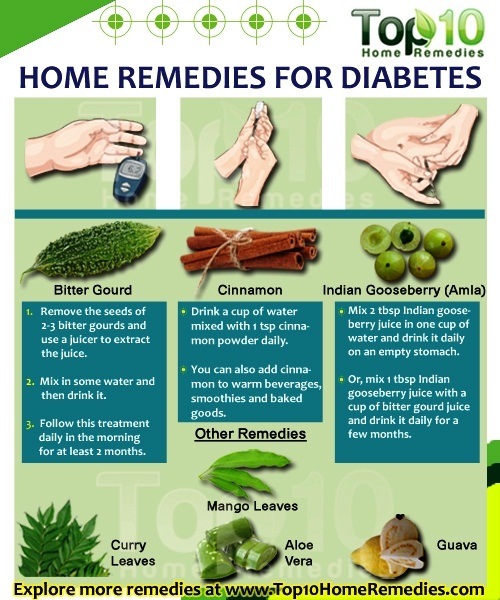HOME REMEDIES FOR DIABETES
Diabetes, also called diabetes mellitus, has become a very common heath problem. There are two main types of diabetes- type 1 diabetes in which the body does not produce insulin and type 2 diabetes in which the body does not produce enough insulin or the insulin that is produced does not work properly.
Some of the common symptoms of diabetes include fatigue, weight loss (even though you are eating more), excessive thirst, increased urination, cut and bruises that are slow to heal and blurred vision.
While there is no cure for diabetes, with your blood sugar level under control you can live a totally normal life. There are various natural remedies for diabetes that will help you control your blood sugar level.
Here are the top 10 home remedies for diabetes. Needless to say, you also need to consult a doctor for proper diagnosis and treatment.
(Out of the 10, we have covered 3 highly effective home remedies in this video as well.)
(Out of the 10, we have covered 3 highly effective home remedies in this video as well.)
1. Bitter Gourd
Bitter gourd, also known as bitter melon, can be helpful for controlling diabetes due to its blood glucose lowering effects. It tends to influence the glucose metabolism all over your body rather than a particular organ or tissue.
It helps increase pancreatic insulin secretion and prevents insulin resistance. Thus, bitter gourd is beneficial for both type 1 and type 2 diabetes. However, it cannot be used to entirely replace insulin treatment.
- Drink some bitter gourd juice on an empty stomach each morning. First remove the seeds of two to three bitter gourds and use a juicer to extract the juice. Add some water and then drink it. Follow this treatment daily in the morning for at least two months.
- Also, you can include one dish made of bitter gourd daily in your diet.
2. Cinnamon
Powdered cinnamon has the ability to lower blood sugar levels by stimulating insulin activity. Itcontains bioactive components that can help prevent and fight diabetes.
Certain trials have shown that it can work as an effective option to lower blood sugar levels in cases of uncontrolled type-2 diabetes.
Cinnamon, however, should not be taken in excess because we commonly use Cassia cinnamon (found in most grocery stores) which contains a compound called coumarin. It is a toxic compound that increases the risk of liver damage.
There is another variety of this herb known as Ceylon cinnamon or “true cinnamon.” It is considered safer for health but its effects on blood glucose levels have not been studied adequately.
- Mix one-half to one teaspoon of cinnamon in a cup of warm water. Drink it daily.
- Another option is to boil two to four cinnamon sticks in one cup of water and allow it to steep for 20 minutes. Drink this solution daily until you see improvement.
- You can also add cinnamon to warm beverages, smoothies and baked goods.
3. Fenugreek
Fenugreek is an herb that can also be used to control diabetes, improve glucose tolerance and lower blood sugar levels due to its hypoglycaemic activity. It also stimulates the secretion of glucose-dependent insulin. Being high in fiber, it slows down the absorption of carbohydrates and sugars.
- Soak two tablespoons of fenugreek seeds in water overnight. Drink the water along with the seeds in the morning on an empty stomach. Follow this remedy without fail for a few months to bring down your glucose level.
- Another option is to eat two tablespoons of powdered fenugreek seeds daily with milk.
4. Indian Gooseberry (Amla)
Indian gooseberry, also known as Amla, is rich in vitamin C and Indian gooseberry juice promotes proper functioning of your pancreas.
- Take two to three Indian gooseberries, remove the seeds and grind it into a fine paste. Put the paste in a cloth and squeeze out the juice. Mix two tablespoon of the juice in one cup of water and drink it daily on an empty stomach.
- Alternatively, mix one tablespoon of Indian gooseberry juice in a cup of bitter gourd juice and drink it daily for a few months.
5. Black Plum or Indian Black Berry (Jambul)
Black plum or jambul, also known as jamun can help a lot in controlling blood sugar level because it contains anthocyanins, ellagic acid, hydrolysable tannins etc.
Each part of the Jambul plant such as the leaves, berry and seeds can be used by those suffering from diabetes. In fact, research has shown that the fruits and seeds of this plant have hypoglycemic effects as they help reduce blood and urine sugar levels rapidly.
The seeds, in particular, contain glycoside jamboline and alkaloid jambosine that regulate control blood sugar levels.
Whenever this seasonal fruit is available in the market, try to include it in your diet as it can be very effective for the pancreas. Else you can make a powder of dried seeds of Jambul fruit and eat this powder with water twice a day. This fruit is native to India and its neighboring countries but you can find it at Asian markets and herbal shops.
6. Mango Leaves
The delicate and tender mango leaves can be used to treat diabetes by regulating insulin levels in the blood. They can also help improve blood lipid profiles.
- Soak 10 to 15 tender mango leaves in a glass of water overnight. In the morning, filter the water and drink it on an empty stomach.
- You can also dry the leaves in the shade and grind them. Eat one-half teaspoon of powdered mango leaves two times daily.

Comments
Post a Comment